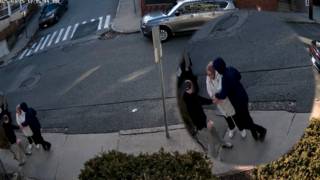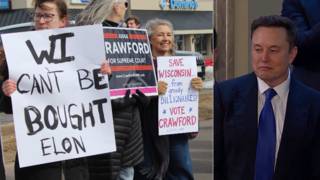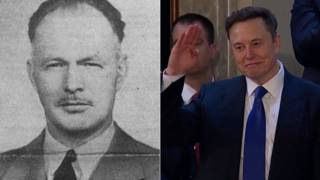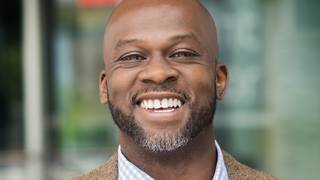
Civil rights activists in Georgia reenacted a 59-year-old lynching this month to push for indictments in the murder of four African Americans, two men and two women, one of whom was seven-months pregnant at the time. No one was ever prosecuted in the case. We speak with the Georgia Association of Black Elected Officials, which organized the reenactment. [includes rush transcript]
The past decade, investigations have been re-opened into some of the most heinous crimes against African-Americans in the south. Some perpetrators of those crimes who are still alive, have finally been prosecuted and convicted. The most recent example is this summer’s trial and conviction of 80-year-old Edgar Ray Killen. Last month, Killen was sentenced to 60 years in prison for orchestrating the 1964 execution of James Chaney, Andrew Goodman and Michael Schwerner–three civil rights workers in Mississippi.
However there a number of other cases throughout the South that remain unsolved. One of those, is a 59 year old crime that many call the last mass lynching in the United States. It took place in Monroe, Georgia, about 40 miles east of Atlanta. Two black men and two women, one who was seven months pregnant, were killed in broad daylight by a white mob at the Moore’s Ford Bridge over the Apalachee River. No one was ever prosecuted in the case. On Monday, members of the community staged a reenactment of the murders and called for the U.S Attorney General’s office to open an investigation into the still unsolved case.
- Tyrone Brooks, Georgia State Representative. He is president of the Georgia Association of Black Elected Officials, which organized the lynching reenactment.
Transcript
AMY GOODMAN: We turn now to Georgia State Representative Tyrone Brooks, joining us on the phone from Atlanta. He’s president of the Georgia Association of Black Elected Officials, which organized the re-enactment of the lynching. Welcome to Democracy Now!, Representative Brooks.
TYRONE BROOKS: Well, good morning, and thank you for having me. The Georgia Association of Black Effected Officials is honored to be on your program this morning.
AMY GOODMAN: Describe the re-enactment and why you did it.
TYRONE BROOKS: Well, it was as much as possible following the timeline of July 25, 1946, from approximately 4:30 p.m. until 7:00 p.m. We followed the timeline of the lynchings as much as we could. We went back to the home of Barney Hester. Barney Hester lives out in the rural area. This is where the fight started between Roger Malcolm and Barney Hester, out on Hester Town Road right outside of the city of Monroe. We started there at 4:30 p.m. We came back to the jail in downtown Monroe, where Roger Malcolm was held for 11 days, upstairs in cell number two on the east side of the jail.
We left the jail, and we went over to the Moore’s Ford Bridge, arriving at approximately 6:00 p.m., because, you see, from the jail to the bridge, it took Mr. Loy Harrison, the white farmer, who bonded him out — got him out of jail — and took his wife, Dorothy, and Mae Murray Dorsey and George, and took them over to the bridge. It probably took him about twenty to thirty minutes. He went the long route. He didn’t go the short route going back to the farm of Barney Hester. And so, when Laura Harrison arrived at the bridge, at approximately 6 p.m., Loy Harrison and the Ku Klux Klan had already planned that they were going to lynch these two African American couples. So the bridge was blocked. We had cars blocking the bridge.
The car carrying Loy Harrison and Dorothy and Mae Murray Dorsey and Roger and George, they pulled up and the Ku Klux Klan was waiting. And the Ku Klux Klan pulled the two men out of the car first and beat them and drug them down the hill and put a rope around Roger’s neck. And then the Klan grabbed the two women, because the two women had recognized some of the Klan members. The Klan members were not covered. Their faces were open. They did not wear masks. They were not concealing their identity in any way. So, the Klan said: 'We better kill these two nigger women.' So the Klan went back up to the car, drug them out, beat them, broke their arms because the women were fighting back — broke their arms, pulled them down the hill and lined all of them up, beat them again, beat them severely, and then they shot them multiple times, multiple times, shot them many, many times.
And then they stood over them and just laughed and grinned and talked about what a success it had been and how great everybody had performed their roles. And there was a law enforcement car from South Carolina. There was a Walton County sheriff deputy’s car from Monroe; so we tried to bring it back to life as much as possible.
Now, we are not professionals. I’m a civil rights worker. That’s all I’ve done all my life. The rest of the persons were local citizens from the community. They were not professional actors; but many people who have seen it on network television and local media and in the papers, The New York Times and USA Today and local media down here, they said: 'Oh, my God, this looks so real!' We tried to bring it to the American people, and to the world as much as possible; and we wanted the world and the American people to see what the Malcolms and the Dorseys experienced. We wanted that horror to come out, so that people could understand the brutality of this domestic terrorism that inflicted African Americans for many, many years. And God knows, in Monroe, Georgia, the Ku Klux Klan controlled everything in 1946.
JUAN GONZALEZ: Well, Representative Brooks, I’d like to ask you, what was the outcome after the killings? I know President Truman ordered an F.B.I. investigation that went nowhere; but are there any witnesses still alive, or are there any of the suspected killers that are still alive?
TYRONE BROOKS: Yes. There are some witnesses still alive. There’s one that lives in Florida. His name is Clinton Adams. Mr. Adams is probably approaching 80 years old now. He was interviewed by the F.B.I., interviewed by the G.B.I. [Georgia Bureau of Investigation], interviewed by the Atlanta Journal-Constitution and many media outlets. I was in the room with Mr. Roy Jackson, an 85-year-old black man, who was a witness. He died in 1998, but, thank be to God, having an F.B.I. agent in the room with us in 1998 in Monroe, the F.B.I. agent decided that he would go get a video camera. So, we have Mr. Roy Jackson’s testimony on video. It’s a part of the evidence.
AMY GOODMAN: How many of the alleged perpetrators are alive?
TYRONE BROOKS: We believe there are at least five living.
AMY GOODMAN: We called the Justice Department and asked them to join us. They said that they would — they haven’t opened an investigation. They would consider it if a request was made.
TYRONE BROOKS: Well, a request will be made, I can promise you that. We’ve been talking to members of the Department of Justice and former members of the Department of Justice. We’ve been talking to a good friend who has been a U.S. Attorney in the Northern District down here in Atlanta, but also he worked in the U.S. Department of Justice as one of the number two deputies under former Attorney General, John Ashcroft. We are trying to get the new Attorney General, Alberto Gonzales, to take a look at this case and consider resuming authority and control over it. The reason is, we have no faith in the local officials to prosecute. Local officials have been part of the problem. The local officials were part of the lynchings, and we don’t ever expect the local officials to prosecute, because they’d be prosecuting some of their own relatives.
AMY GOODMAN: Tyrone Brooks. I want to thank —
TYRONE BROOKS: They’ve always tried to protect their relatives.
AMY GOODMAN: We want to thank you very much for being with us. Georgia State Representative, organized the re-enactment of a quadruple lynching that took place almost sixty years ago, hoping to get indictments today.












Media Options